Nodebox demos¶
This is a selection of demos from Nodebox 1, by the Nodebox authors (Frederik de Bleser and Tom de Smedt), with slight edits.
Math sculpture¶
Generates sculptures using a set of mathematical functions. Every iteration adds a certain value to the current coordinates. Rewriting this program to use transforms is left as an exercise for the reader.
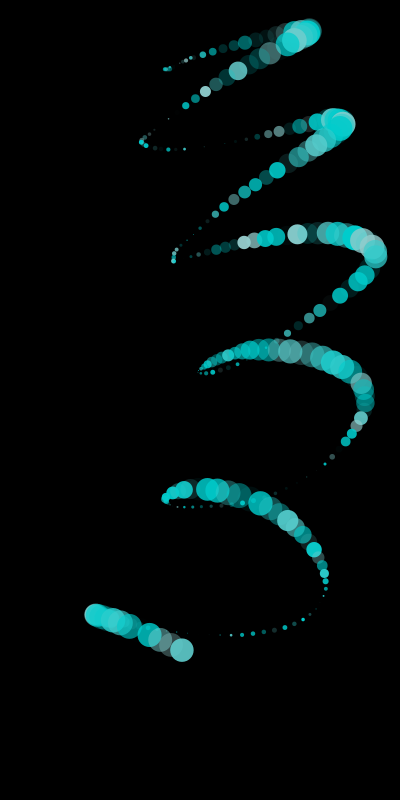
from math import sin, cos, log10
size(400, 800)
background(0)
cX = random(1, 10)
cY = random(1, 10)
x = 200
y = 54
fontsize(10)
for i in range(278):
x += cos(cY) * 11
y += log10(cX) * 1.85 + sin(cX) * 5
fill(random() - 0.4, 0.8, 0.8, random())
s = 10 + cos(cX) * 15
oval(x - s / 2, y - s / 2, s, s)
# Try the next line instead of the previous one to see how
# you can use other primitives.
# star(x-s/2, y-s/2, random(5, 10), inner=2+s*0.1, outer=10+s*0.1)
cX += random(0.25)
cY += random(0.25)
Color grid¶
This example showcases the HSB color mode to select colors more naturally, by specifying a hue, saturation and brightness.
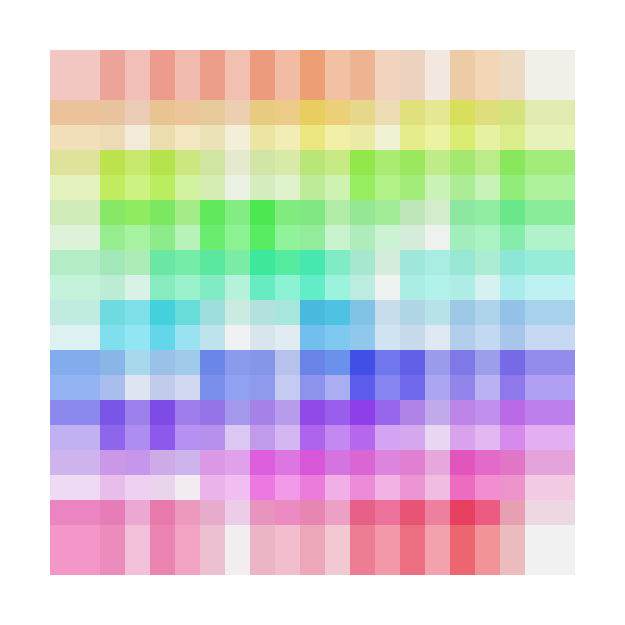
size(625, 625)
colormode(HSB)
# Set some initial values. You can and should play around with these.
h = 0
s = 0.5
b = 0.9
a = 0.5
# Size is the size of one grid square.
square_size = 50
# Using the translate command, we can give the grid some margin.
translate(50, 50)
# Create a grid with 10 rows and 10 columns. The width of the columns
# and the height of the rows is defined in the 'size' variable.
for x, y in grid(10, 10, square_size, square_size):
# Increase the hue while choosing a random saturation.
# Try experimenting here, like decreasing the brightness while
# changing the alpha value etc.
h += 0.01
s = random()
# Set this to be the current fill color.
fill(h, s, b, a)
# Draw a rectangle that is one and a half times larger than the
# grid size to get an overlap.
rect(x, y, square_size * 1.5, square_size * 1.5)
Ball grid¶
Use a grid to generate a bubble-like composition.
This example shows that a grid doesn’t have to be rigid at all. It’s very easy to break loose from the coordinates Shoebot passes you, as is shown here. The trick is to add or subtract something from the x and y values Shoebot passes on. Here, we also use random sizes.
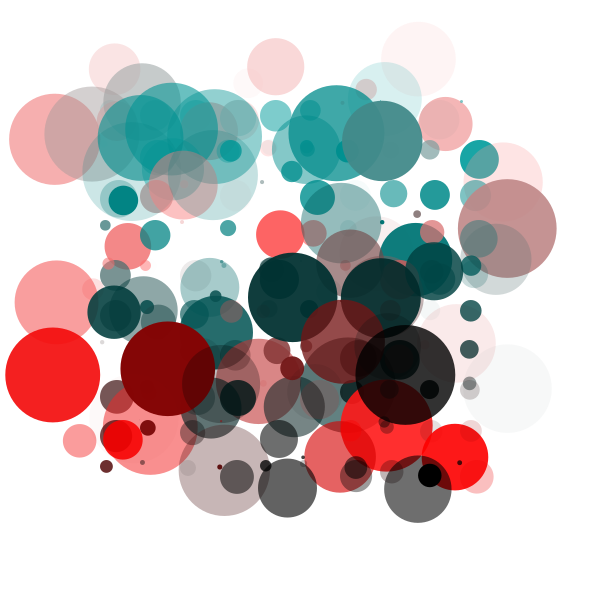
from math import sin, cos
size(600, 600)
gridSize = 40
# Translate a bit to the right and a bit to the bottom to
# create a margin.
translate(100, 100)
startval = random()
c = random()
for x, y in grid(10, 10, gridSize, gridSize):
fill(sin(startval + y * x / 100.0), cos(c), cos(c), random())
s = random() * gridSize
oval(x, y, s, s)
fill(cos(startval + y * x / 100.0), cos(c), cos(c), random())
deltaX = (random() - 0.5) * 10
deltaY = (random() - 0.5) * 10
deltaS = (random() - 0.5) * 200
oval(x + deltaX, y + deltaY, deltaS, deltaS)
c += 0.01
Blines and circloids¶
by Tom de Smedt <https://www.nodebox.net/code/index.php/Blines_and_Circloids>
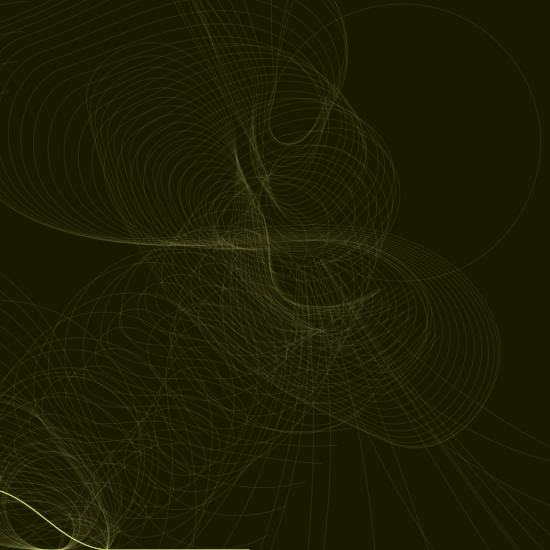
# You'll need the Boids and Cornu libraries.
boids = ximport("boids")
cornu = ximport("cornu")
size(550, 550)
background(0.1, 0.1, 0.0)
nofill()
flock = boids.flock(10, 0, 0, WIDTH, HEIGHT)
n = 70
for i in range(n):
flock.update(shuffled=False)
# Each flying boid is a point.
points = []
for boid in flock:
points.append((boid.x, boid.y))
# Relativise points for Cornu.
for i in range(len(points)):
x, y = points[i]
x /= 1.0 * WIDTH
y /= 1.0 * HEIGHT
points[i] = (x, y)
t = float(i) / n
stroke(0.9, 0.9, 4 * t, 0.6 * t)
cornu.drawpath(points, tweaks=0)
Color grid¶
This example showcases the HSB color mode to select colors more naturally, by specifying a hue, saturation and brightness.

size(625, 625)
colormode(HSB)
# Set some initial values. You can and should play around with these.
h = 0
s = 0.5
b = 0.9
a = 0.5
# Size is the size of one grid square.
square_size = 50
# Using the translate command, we can give the grid some margin.
translate(50, 50)
# Create a grid with 10 rows and 10 columns. The width of the columns
# and the height of the rows is defined in the 'size' variable.
for x, y in grid(10, 10, square_size, square_size):
# Increase the hue while choosing a random saturation.
# Try experimenting here, like decreasing the brightness while
# changing the alpha value etc.
h += 0.01
s = random()
# Set this to be the current fill color.
fill(h, s, b, a)
# Draw a rectangle that is one and a half times larger than the
# grid size to get an overlap.
rect(x, y, square_size * 1.5, square_size * 1.5)
Circles and Beziers¶
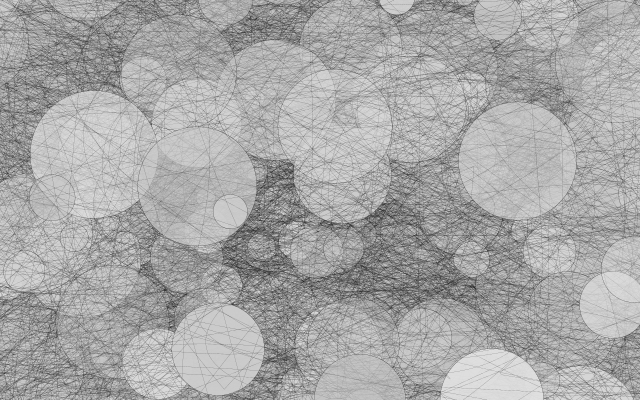
size(640, 400)
colorrange(255)
colormode(HSB)
background(0, 0, 192)
for i in range(0, WIDTH // 4, 1):
# ^ range requires a float, so use integer division '//'
sz = random(WIDTH / 40, WIDTH / 5)
xpos = random(-WIDTH / 5, WIDTH)
ypos = random(-WIDTH / 5, HEIGHT)
fill(0, 0, random(192, 224), random(85, 255))
ellipse(xpos, ypos, sz, sz)
nofill()
stroke(0, 0, 0, 255)
strokewidth(.1)
ellipse(xpos, ypos, sz, sz)
for j in range(0, WIDTH // 80, 1):
# ^ range requires a float, so use integer division '//'
stroke(0, 0, 0, 255)
strokewidth(.1)
beginpath(random(-WIDTH / 2, WIDTH * 1.5), random(-HEIGHT / 2, HEIGHT * 1.5))
curveto(random(-WIDTH / 2, WIDTH * 1.5), random(-HEIGHT / 2, HEIGHT * 1.5),
random(-WIDTH / 2, WIDTH * 1.5), random(-HEIGHT / 2, HEIGHT * 1.5),
random(-WIDTH / 2, WIDTH * 1.5), random(-HEIGHT / 2, HEIGHT * 1.5))
endpath()